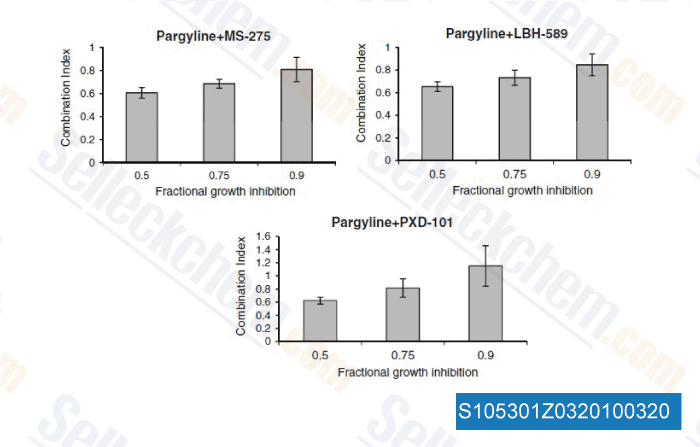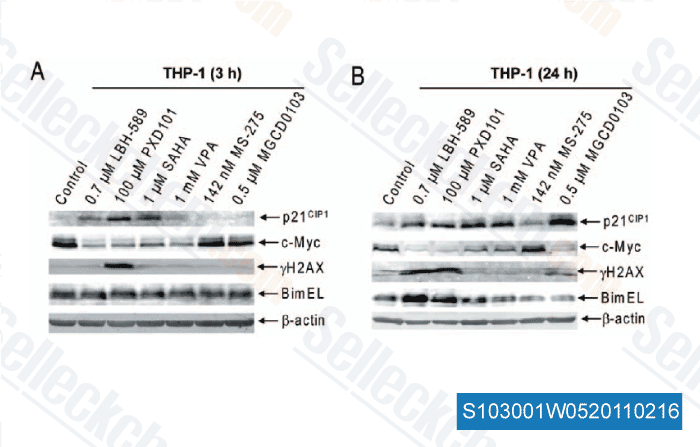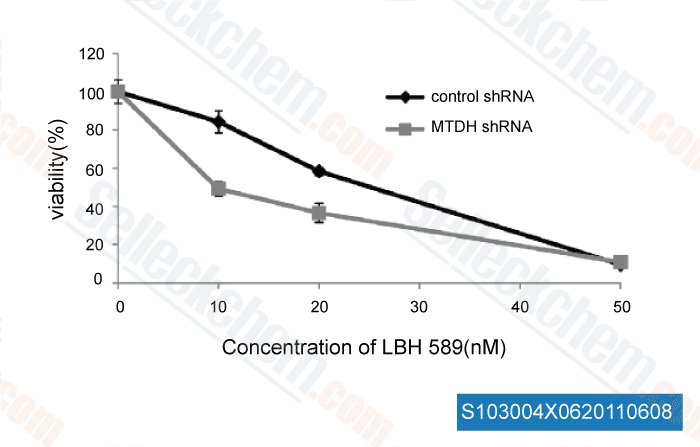|
Toll Free: (877) 796-6397 -- USA and Canada only -- |
Fax: +1-832-582-8590 Orders: +1-832-582-8158 |
Tech Support: +1-832-582-8158 Ext:3 Please provide your Order Number in the email. |
Technical Data
| Formula | C21H23N3O2 |
|||
| Molecular Weight | 349.43 | CAS No. | 404950-80-7 | |
| Solubility (25°C)* | In vitro | DMSO | 69 mg/mL (197.46 mM) | |
| Water | Insoluble | |||
| Ethanol | Insoluble | |||
|
* <1 mg/ml means slightly soluble or insoluble. * Please note that Selleck tests the solubility of all compounds in-house, and the actual solubility may differ slightly from published values. This is normal and is due to slight batch-to-batch variations. * Room temperature shipping (Stability testing shows this product can be shipped without any cooling measures.) |
||||
Preparing Stock Solutions
Biological Activity
| Description | Panobinostat (LBH589, NVP-LBH589) is a novel broad-spectrum HDAC inhibitor with IC50 of 5 nM in a cell-free assay. Panobinostat (LBH589) induces autophagy and apoptosis. Panobinostat effectively disrupts HIV latency in vivo. Phase 3. | ||||
|---|---|---|---|---|---|
| Targets |
|
||||
| In vitro | LBH589 induces apoptosis among MOLT-4 and Reh cells in a time- and dose-dependent manner. Moreover, LBH589 is more potent in MOLT-4 than in Reh cells. LBH589 markedly prevents the growth of both MOLT-4 and Reh cells in a dose-dependent manner at 48 hours. LBH589 treatment causes a 2- to 3-fold increase in the number of cells in the G2/M phase of the cell cycle compared with the control cells. LBH589 is associated with induction of histone H3K9 and histone H4K8 acetylation as well as decreasing levels of c-Myc expression in a dose-dependent manner. LBH589 treatment also increases the levels of p21 expression. LBH589 treatment also decreases the levels of c-Myc after an initial increase at the lowest dose (10 nM) in Reh cells. In addition, LBH589 gives rise to substantial increases in mRNA levels of proapoptosis and DNA repair genes. LBH589 induces increased levels of acetylated histone H3 and H4 at the GADD45G promoter. [1] Besides, LBH589 inhibits growth of non small cell lung cancer cell lines (such as human H1299, L55 and A549 with IC50 of 5 nM, 11 nM and 30 nM, respectively), mesothelioma (such as human OK-6 and Ok-5 with IC50 of 5 nM and 7 nM, respectively) and small cell lung cancer cell lines (such as human RG-1 and LD-T with IC50 of 4 nM and 5 nM, respectively). [2] | ||||
| In vivo | In lung cancer and mesothelioma animal models, LBH589 markedly decreases tumor growth by 62%. LBH589 is equally effective in immunocompetent and severe combined immunodeficien-cymice, suggesting that the inhibition of tumor growth by LBH589 is not due to direct immunologic effects. Daily LBH589, given i.p. at 20 mg/kg for 5 days per week, leading to an average decrease in growth of 70%. Compared with the corresponding control tumors, LBH589 leads to a 53% decrease for H526-derived tumors, an 81% decrease for BK-T-derived tumors, a 76% decrease for RG-1- derived tumors, and a 70% decrease for H69-derived tumors. In contrast to the lack of tumor regression notes in NSCLC and Meso-derived xenografted tumors that are treated under identical conditions and doses, LBH589 results in dramatic tumor regression in SCLC-derived tumors and RG-1-derived tumor. [2] |
Protocol (from reference)
| Cell Assay:[1] |
|
|---|---|
| Animal Study:[2] |
|
References
Customer Product Validation

-
Data from [Breast Cancer Res Treat , 2012, 131, 777-789]

-
Data from [PLoS One, 2011, 6, e17138]

-
Data from [PLoS One, 2011, 6, e17138]

-
Data from [PLoS One, 2011, 6, e20920]
Selleck's Panobinostat (LBH589) has been cited by 448 publications
| Blood and tissue HIV-1 reservoirs display plasticity and lack of compartmentalization in virally suppressed people [ Nat Commun, 2025, 16(1):2173] | PubMed: 40038305 |
| Intratumor heterogeneity of EGFR expression mediates targeted therapy resistance and formation of drug tolerant microenvironment [ Nat Commun, 2025, 16(1):28] | PubMed: 39747003 |
| Spatial covariance reveals isothiocyanate natural products adjust redox stress to restore function in alpha-1-antitrypsin deficiency [ Cell Rep Med, 2025, 6(1):101917] | PubMed: 39809267 |
| A patient-derived T cell lymphoma biorepository uncovers pathogenetic mechanisms and host-related therapeutic vulnerabilities [ Cell Rep Med, 2025, S2666-3791(25)00102-8] | PubMed: 40147445 |
| HDAC and MEK inhibition synergistically suppresses HOXC6 and enhances PD-1 blockade efficacy in BRAFV600E-mutant microsatellite stable colorectal cancer [ J Immunother Cancer, 2025, 13(1)e010460] | PubMed: 39800382 |
| HAT1/HDAC2 mediated ACSL4 acetylation confers radiosensitivity by inducing ferroptosis in nasopharyngeal carcinoma [ Cell Death Dis, 2025, 16(1):160] | PubMed: 40050614 |
| Impaired ARID1A expression attenuated the immune response in gastric cancer via histone acetylation [ Clin Epigenetics, 2025, 17(1):2] | PubMed: 39754248 |
| Prmt5 is essential for intestinal stem cell maintenance and homeostasis [ Cell Regen, 2025, 14(1):5] | PubMed: 39907873 |
| HDAC activity is dispensable for repression of cell-cycle genes by DREAM and E2F:RB complexes [ Nat Commun, 2024, 15(1):4450] | PubMed: 38789411 |
| Acetylation-dependent regulation of core spliceosome modulates hepatocellular carcinoma cassette exons and sensitivity to PARP inhibitors [ Nat Commun, 2024, 15(1):5209] | PubMed: 38890388 |
RETURN POLICY
Selleck Chemical’s Unconditional Return Policy ensures a smooth online shopping experience for our customers. If you are in any way unsatisfied with your purchase, you may return any item(s) within 7 days of receiving it. In the event of product quality issues, either protocol related or product related problems, you may return any item(s) within 365 days from the original purchase date. Please follow the instructions below when returning products.
SHIPPING AND STORAGE
Selleck products are transported at room temperature. If you receive the product at room temperature, please rest assured, the Selleck Quality Inspection Department has conducted experiments to verify that the normal temperature placement of one month will not affect the biological activity of powder products. After collecting, please store the product according to the requirements described in the datasheet. Most Selleck products are stable under the recommended conditions.
NOT FOR HUMAN, VETERINARY DIAGNOSTIC OR THERAPEUTIC USE.
